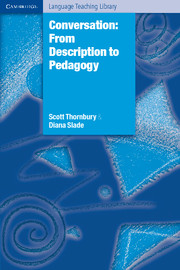Book contents
- Frontmatter
- Contents
- Thanks and acknowledgements
- Dedication
- Introduction
- 1 Characterizing conversation
- 2 The vocabulary of conversation
- 3 The grammar of conversation
- 4 The discourse features of conversation
- 5 Genres in conservation: Storytelling and gossiping
- 6 Acquiring L1 conversational competence
- 7 Acquiring L2 conversational competence
- 8 Teaching conversation: A history
- 9 Teaching conversation: Approach, design, procedure and process
- Task key
- References
- Author index
- Subject index
4 - The discourse features of conversation
Published online by Cambridge University Press: 04 May 2010
- Frontmatter
- Contents
- Thanks and acknowledgements
- Dedication
- Introduction
- 1 Characterizing conversation
- 2 The vocabulary of conversation
- 3 The grammar of conversation
- 4 The discourse features of conversation
- 5 Genres in conservation: Storytelling and gossiping
- 6 Acquiring L1 conversational competence
- 7 Acquiring L2 conversational competence
- 8 Teaching conversation: A history
- 9 Teaching conversation: Approach, design, procedure and process
- Task key
- References
- Author index
- Subject index
Summary
Introduction
In Chapter 1 we described a number of approaches to the study of conversation. Common to each of these approaches is the concern to interpret language within a socio-cultural context, and by doing so to relate the language features to social factors. It is precisely because of this interest in the relationship between language and social factors that conversation is seen as crucial. Depending on the theoretical underpinnings, conversation is seen either as the key to understanding social life (as in the socio-linguistic approaches, for example), or as a way of shedding light on the nature of language itself (as in the linguistic approaches). What they share is the belief in the social nature of language: that conversation builds social contexts at the same time as these contexts guide and shape conversation. Such an interest, departing from formal linguistics, leads to an interest in discourse. Formal grammars focus on the lexical and grammatical properties of sentences, whereas socially oriented, functional approaches focus not only on the grammar and lexis but also on the analysis of the surrounding discourse – that is, on the analysis of texts in social contexts. Chapters 2 and 3 described the vocabulary and grammar of conversational English and in this chapter we will continue to build up this picture of spoken language by focusing on linguistic features of extended text as well the links between text and its social context.
Discourse is language functioning in its context of use. It is what we engage in throughout the course of our daily lives – from talking at breakfast, to reading a newspaper, to chatting on the bus, to teaching a class.
- Type
- Chapter
- Information
- ConversationFrom Description to Pedagogy, pp. 107 - 141Publisher: Cambridge University PressPrint publication year: 2006



